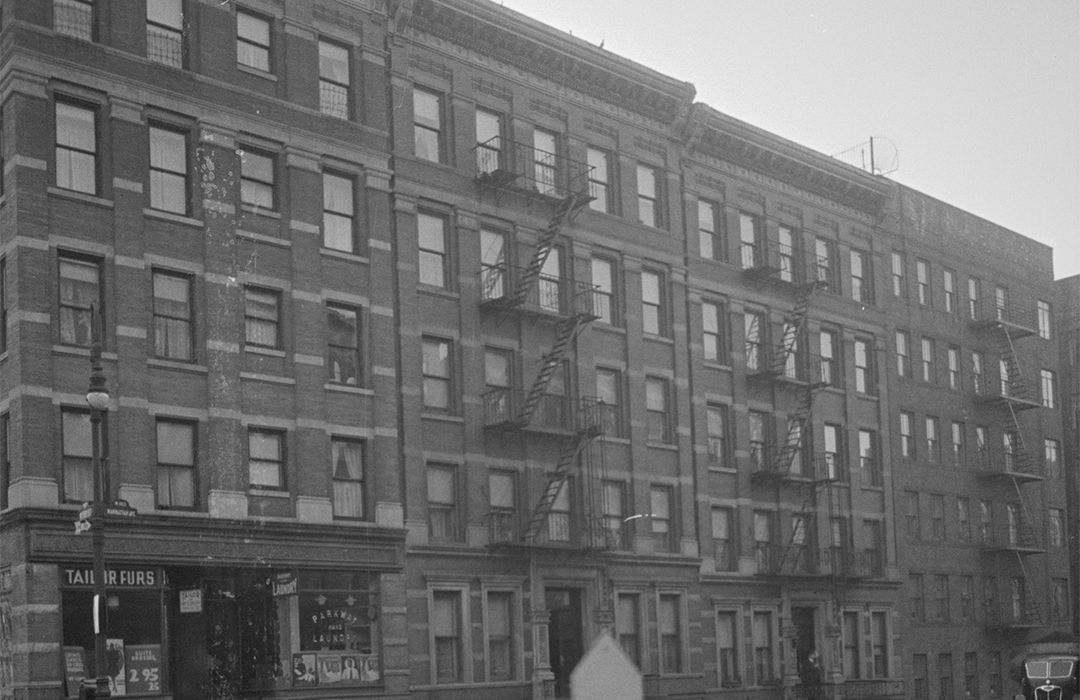
60 Manhattan Ave.
by Tom Miller
On October 25, 1895, architect John C. Burne filed plans for three “five-story brick flats” at the southeast corner of Manhattan Avenue and 103rd Street. The middle building, 60 Manhattan Avenue, would cost developer Nicholas Cotter $25,000 to erect, or about $936,000 in 2025 terms.
While Burne gave the building an Italian Renaissance Revival-style entrance, the upper floors were neo-Grec in style. Faced in buff-colored Roman brick, the three-story piers of the midsection were banded with stone and capped with carved capitals. An ebullient, bracketed cornice finished the design.
Completed in 1896, there were 20 apartments within the building. Among the initial residents was architect Leonard Schultze, who worked in the offices of Warren & Wetmore. (Decades later, in 1921, he would partner with S. Fullerton Weaver as Schultze & Weaver.) Three actresses, Blanche Vernon, Agnes Milton and Mabel Power, were also initial residents.
Mabel Power was 19 years old when she, her older sister, and her mother, Alice A. Power, moved in. Mabel was a member of May Irwin’s theatrical troupe and was appearing in Courted Into Court. In October 1896, she began seeing 22-year-old Walter F. Loeb, the son of affluent attorney Charles Loeb.
On March 16, 1897, Walter took Mabel to the matinee of My Friend from India at Daly’s Theatre. He had been pressing Mabel to marry him for weeks, but she had been “putting him off,” according to her mother. But today he would not be denied. Alice said, “he insisted,” and after the play, he and her daughter hurried to the Little Church Around the Corner (known as the Actors’ Church). They were married in the parsonage with the minister’s servants acting as witnesses.
“After the show, Mabel and Walter went to a hotel, intending to start on their wedding tour at the end of the week…”
Mabel did not tell her mother about the wedding. She telephoned, saying that she would not be home that night and would be staying at the home of a young lady in the company. The newlyweds then had supper, and Mabel went on stage as usual. Alice later explained, “After the show, Mabel and Walter went to a hotel, intending to start on their wedding tour at the end of the week. At noon the next day, Walter said he would have to go home and explain his absence overnight.”
Walter’s explanation to his parents that he was married did not go well. At 6:00 that evening, Walter returned. During dinner, he told Mabel that “his father had raised an awful row and threatened to disinherit him.” Charles Loeb demanded that Walter have the marriage immediately annulled. Mabel came home that night and told her mother everything.
Alice said later, “I wanted to learn what excuse a man could give for deserting a girl the day after marrying her, and I started out.” She made inquiries and “learned that the Leob family claimed that Walter married Mabel while in a trance, or that he was intoxicated.” The Rev. Mr. Butler insisted, “Walter was perfectly sober.” Because Mabel was not yet 21 years old, Alice represented her in court on May 3, 1897, during the separation hearing. She told the court, “My daughter’s heart is broken.”
Living here in 1903 were two unmarried young women Fanny F. Rhoades, who taught in Public School 67 on West 46th Street; and Lillian Read, who moved here in 1900 from Chicago. Lilian was hired by the law firm F. Schmidt & Co. as a “confidential stenographer and typewriter,” or what today would be termed an administrative assistant.
Lillian Read left for a two-week vacation on July 25, 1904. When she returned to the office on August 8, according to co-workers, she “seemed to be somewhat downcast.” While she was gone, something grave had happened to the 26-year-old. The next day, at noon, the entire staff—except Lillian–left for lunch. Instead, she entered the office of F. Schmidt, locked the door, and sat in a chair near the window. When Schmidt returned from lunch, he found his office locked. The Herald Dispatch reported, “He stood on a chair and looked over the partition and saw the young woman lying on the chair, with arms outstretched. The door was broken open and [an] emptied carbolic acid bottle was found.” Lillian died shortly after arriving at the hospital.
Publisher, lecturer and author Edward Hagaman Hall, his wife, the former Irene Gilbert Gazzam, and their daughter, Edwina Gazzam Hall, lived here as early as 1908. Born in 1858, Hall married Irene on February 7, 1893. Edwina was born the following year. He was the author of numerous books “relating to American history, scenery, archeology and biography,” according to Men of America. His exhausting resume included secretary of the American Scenic and Historic Preservation Society and secretary of the Association for the Protection of the Adirondacks. He was also governor of the New York Society of the Order of Founders and Patriots of America, a governor of the National Arts Club of New York, second vice-president of the City History Club, former vice-president of the Sons of the American Revolution, and a member of numerous other organizations. The Hall family would remain here for years.
In 1900, resident Walter G. Weston was appointed Deputy Collector of Internal Revenue in the Second New York District by President William McKinley. Weston was born in 1843 in Canton, Ohio, where he had been friends with the future President. He was an amateur artist, and in 1915, The New York Times said, “his home was decorated with his art.”
The next day, at noon, the entire staff—except Lillian–left for lunch.
H. Hecor left Manhattan Avenue to serve in the Army when America entered World War I. He held the rank of sergeant-major with the 102d Engineers by April 1919, when he was payroll master at Camp Merrit, New Jersey. Previously, he had been stationed at Camp Upton in Yaphank, New York. Now he spoke out about the conditions at his former camp. On April 5, 1919, the New York Herald Dispatch quoted him:
There was not enough food issued, and what there was was spoiled in cooking. The beans were half cooked, the spaghetti or macaroni was a pasty mass, and the apricots appeared to have been thrown into hot water for a few minutes and then fished out again. We cannot understand why we were treated so badly in the matter of food, after being so well fed at Camp Merritt.
Residents of 60 Manhattan Avenue most often had at least one servant. In 1919, Dr. Gabriel Costa and his wife hired a nurse, Dorothea Aquina, “who recently arrived in this country,” according to The New York Times. On August 22, Dorothea took the two Costa children out for a stroll. But, unfamiliar with the neighborhood and unable to remember her address, she became helplessly lost. After wandering for four hours, she saw a foot patrolman. The newspaper reported, “A good looking young Spanish woman, carrying a 10-month-old baby girl in her arms and a 4-year-old boy tugging at her dress, approached Patrolman John Nelson…and in broken English said she was lost.”
Through an interpreter, Dorothea was able to explain her story. While detectives went out to track down Dr. Costa, the frazzled nurse and the children were given something to eat in the station house. Dorothea Aquina’s nerve-wracking story had a happy ending. The New York Times reported, “Dr. Gabriel Costa…went to the station late last night and identified the nurse and his two children.”
The building continued to be home to middle-class families throughout the century. There are still 20 apartments at 60 Manhattan Avenue. Outwardly, it survives nearly unchanged since the first occupants moved in nearly 130 years ago.
Tom Miller is a social historian and blogger at daytoninmanhattan.blogspot.com


